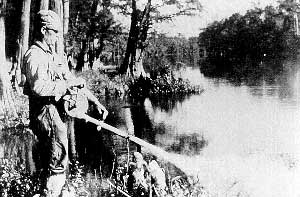When pharmaceutical companies develop new medicines, the Food & Drug Administration requires extensive testing of both effectiveness and side effects. Anticipating side effects poses a considerable challenge, since there are many variables involved. Such variables include the user’s age, gender, lifestyle, genetics, pre-existing conditions, etc.
Imagine how difficult it is to anticipate the effects of a change on an “organism” as complex as an entire planet. Earth consists of an atmosphere, land, and water bodies. It is inhabited by an almost infinite variety of life forms. These creatures and their habitats are inextricably linked in a complex set of relationships called an ecosystem. When we interfere with one element of an ecosystem, there are often unanticipated consequences to another component. While trying to solve one problem, we sometimes unintentionally create another problem that is even worse. Here are three vivid examples of the curse of unintended consequences.
 |
| Malaria was eradicated from many areas of the U.S. by spraying the pesticide DDT to control mosquitoes. CDC photo, 1958 |
PROTECTING PUBLIC HEALTH AND CROPS: The chemical DDT was first synthesized in 1874. Its effectiveness as a pesticide was recognized in 1939 by Dr. Paul Müller, who won a Nobel Prize for his work with this miracle chemical. During World War II, the U.S. started mass production to control typhus and malaria abroad. After 1945, DDT was widely used in agricultural and commercial applications. It was cheap, effective and versatile. Unfortunately, it was also very toxic, and accumulated in the food chain, affecting non-target organisms like fish. The book Silent Spring, published in 1962, sounded an alarm about the impact of pesticides like DDT on wildlife. The U.S. Environmental Protection Agency cancelled all crop uses of DDT in the U.S. effective December 31, 1972. However, over a 30 year period, 1,350,000,000 lbs. of DDT were introduced into the environment.
IN SEARCH OF A SAFER ALTERNATIVE: After some people died in the 1920's when methyl chloride leaked out of refrigerators, the search for a less toxic refrigerant began. Chlorofluorocarbons (CFCs) were first synthesized in 1928. By 1935, eight million refrigerators with Freon-12 (a CFC) had been sold. In time, CFCs were widely used in air conditioners, and as cleaning agents, propellants in aerosol cans, etc. In 1974, scientists started to realize that man-made organic halogen compounds like CFCs attack the ozone layer. A blanket of ozone absorbs ultraviolet radiation from the sun, making life on earth possible. If that blanket thins, it could cause problems like skin cancer, cataracts, and unpredictable damage to the food chain. Fifty years after their creation, CFCs were banned in aerosol cans in the U.S. Unfortunately, the damage was done. CFCs are still in the stratosphere, and will continue impacting it for decades to come.
ADDITIVES TO IMPROVE PERFORMANCE: For hundreds of years, lead was added to paint to make it dry faster, look fresh, and resist moisture. Since the 1920s, lead was blended with gasoline, primarily to boost octane levels and reduce knocking. Unfortunately, there are serious health impacts associated with lead exposure. For example, lead can cause permanent nerve damage, mental retardation and reproductive problems. Children under the age of six are particularly vulnerable. They sometimes ingest lead dust when it is dislodged from peeling or chipping paint. Humans can also be exposed during remodeling, especially dry sanding, scraping or use of heat guns without HEPA filtered dust collection. As early as 1912, the danger of using lead paint was published in the Journal of the American Medical Association by Dr. Alice Hamilton. However, lead continued to be used in paint across the nation, peaking in the 1920s. Lead paint was not banned for residential use until 1978. Due to health and air pollution concerns, EPA started to phase out leaded gasoline in 1976, but the final step was not completed until 1996.
Eventually we did figure out the unintended consequences of products like these. Decades later, we took steps to phase out their use. However, DDT, CFCs and leaded gasoline are still used for some specialized purposes in the U.S. For example, public health and quarantine uses and exports of DDT were not affected by the EPA order. They are also available in other parts of the world. And we all continue to live with their legacy. |

